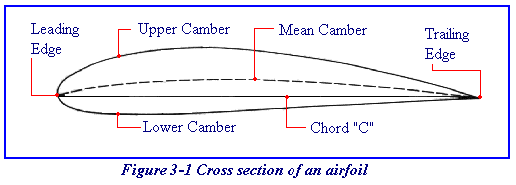 |
|||||
| Home | Research | For Teachers | HISTORY Level 1 Level 2 Level 3 |
PRINCIPLES Level 1 Level 2 Level 3 |
CAREER Level 1 Level 2 Level 3 |
| Gallery | Hot Links | What's New! | |||
| Web Administration and Tools | |||||
 |
|||||
| Home | Research | For Teachers | HISTORY Level 1 Level 2 Level 3 |
PRINCIPLES Level 1 Level 2 Level 3 |
CAREER Level 1 Level 2 Level 3 |
| Gallery | Hot Links | What's New! | |||
| Web Administration and Tools | |||||
![]()
An airfoil is any part of an airplane that is designed to produce lift. Those parts of the airplane specifically designed to produce lift include the wing and the tail surface. In modern aircraft, the designers usually provide an airfoil shape to even the fuselage. A fuselage may not produce much lift, and this lift may not be produced until the aircraft is flying relatively fast, but every bit of lift helps.
 Figure 3-1 shows a cross section of a wing, but it could be a tail
surface or a propeller because they are all essentially the same. Locate the leading
edge, the trailing edge, the chord, and the upper and lower camber
on Figure 3-1.
Figure 3-1 shows a cross section of a wing, but it could be a tail
surface or a propeller because they are all essentially the same. Locate the leading
edge, the trailing edge, the chord, and the upper and lower camber
on Figure 3-1.
The leading edge of an airfoil is the portion that meets the air first. The shape of the leading edge depends upon the function of the airfoil. If the airfoil is designed to operate at high speed, its leading edge will be very sharp, as on most current fighter aircraft. If the airfoil is designed to produce a greater amount of lift at a relatively low rate of speed, as in a Cessna 150 or a Cherokee 140, the leading edge will be thick and fat. Actually, the supersonic fighter aircraft and the light propeller-driven aircraft are virtually two ends of a spectrum. Most other aircraft lie between these two.
The trailing edge is the back of the airfoil, the portion at which the airflow over the upper surface joins the airflow over the lower surface. The design of this portion of the airfoil is just as important as the design of the leading edge. This is because the air flowing over the upper and lower surfaces of the airfoil must be directed to meet with as little turbulence as possible, regardless of the position of the airfoil in the air.
The chord of an airfoil is an imaginary straight line drawn through the airfoil from its leading edge to its trailing edge. We might think of this chord line as the starting point for drawing or designing an airfoil in cross section. It is from this baseline that we determine how much upper or lower camber there is and how wide the wing is at any point along the wingspan. The chord also provides a reference for certain other measurements as we shall see.
The camber of an airfoil is the characteristic curve of its upper or lower surface. The camber determines the airfoil's thickness. But, more important, the camber determines the amount of lift that a wing produces as air flows around it. A high-speed, low-lift airfoil has very little camber. A low-speed, high-lift airfoil, like that on the Cessna 150, has a very pronounced camber.
You may also encounter the terms upper camber and lower camber. Upper camber refers to the curve of the upper surface of the airfoil, while lower camber refers to the curve of the lower surface of the airfoil. In the great majority of airfoils, upper and lower cambers differ from one another.
Send all comments to ![]() aeromaster@eng.fiu.edu
aeromaster@eng.fiu.edu
© 1995-98 ALLSTAR Network. All rights reserved worldwide.
| Funded in part by | From Civil Air Patrol Educational Materials |
Updated: February 23, 1999